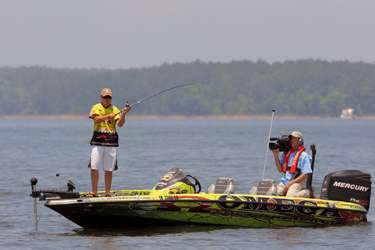
While growing up in Minnesota, Derek Remitz honed his skills catching bass on jerkbaits. He still considers jerkbait fishing one of his favorite techniques but since he has become an Elite Series pro and moved to Alabama, he has also grown fond of a jig because of its big fish potential.
“Most of the times or situations when you throw a jig you have a good percentage of catching a big fish on it,” he says.
“It has been like that since (Tommy) Biffle started flipping a jig.” The jig has also produced big fish for Remitz, who caught 20 bass weighing 111 pounds, 7 ounces in four days on a football jig to win the 2007 Battle on the Border at Lake Amistad.
While jig manufacturers have flooded the market with a variety of jig styles for swimming, casting, flipping and finesse tactics, Remitz sticks with three basic styles — a football jig, flipping jig and grass jig. “I don’t vary a whole lot,” he says. “As for football jigs, I use my (Omega Custom Tackle) jig all the time in 3/4 or 1 ounce and in certain situations the 1/2 ounce for shallower water or a slower presentation.”
For flipping and pitching around shallow cover, Remitz relies on the 1/2-ounce Omega Custom Tackle Flippin’ Jig. Remitz opts for a 1-ounce Omega Pro-MEGA Flippin’ Jig when he wants to flip hydrilla and other matted vegetation. Remitz offers the following details on how he fishes each of his favorite jig styles.
Football Jig
Applications: Most of the time Remitz fishes the football jig from 5 to 15 feet deep along offshore structure, but he caught fish on it as deep as 50 to 60 feet during the Battle on the Border. When he fishes Clarks Hill, Remitz will throw the 1/2-ounce football jig up on the bank and reel it steadily along the bottom in water as shallow as 2 feet.
“There are those long flat points (at Clarks Hill) and the fish are up there along isolated rock piles. When fishing shallow like that the football jig is a good way for me to cover water quicker.”
Colors: Ozark Special (brown with green strands and Table Rock (brown with purple strands).
Trailers: “I almost always put a Yamamoto 5-inch (green pumpkin) Hula Grub on my football jigs. There are certain times when I might go to something different like putting a Senko on it or a Brush Hog when I want to give it a real big profile.”
Tackle: 7-foot medium-heavy St. Croix Legend Elite rod and 7.0.1 gear ratio baitcast reel with 14- or 16-pound fluorocarbon line.
Flipping Jig
Applications: Remitz relies on this jig for flipping to stumps, laydowns, bushes and boat docks in shallow water. “If I am flipping bushes I try to flip to the middle of the bush and jig it once or twice. Most of the time the better fish hit it on the initial fall.”
Colors: Black-and-blue or Chobee craw (brown with blue). He favors a black-and-blue jig for flipping in stained to dirty water and the Chobee Craw hue for clear water.
Trailers: A NetBait Paca Craw or Paca Chunk in the same color scheme as his jig.
Tackle: Same rod and reel Remitz uses for his football jig, but he switches to 20-pound fluorocarbon line.
Grass Jig
Applications: Flipping deep hydrilla and since Remitz lives on Lake Guntersville now, the Pro-MEGA Flipp’n model is his favorite jig for fishing the weeds on his home lake in the fall.
Colors: Same as the flipping jig. “I kind of believe that it is not so much the color on a jig as it is getting it in front of a fish. A black-and-blue jig has caught so many fish over the years so I might as well flip a proven color.”
Trailers: 5-inch Paca Craw in the same colors as his jig.
Tackle: 7 1/2-foot St. Croix flipping stick and 7.0:1 gear ratio reel with 50-pound braided line. If the grass is getting heavy fishing pressure, Remitz scales down his line to 20-pound fluorocarbon.
Editor’s Note: If you have a story idea you would like to vote on for an upcoming poll, send your idea to john@jnoutdoors.com.





